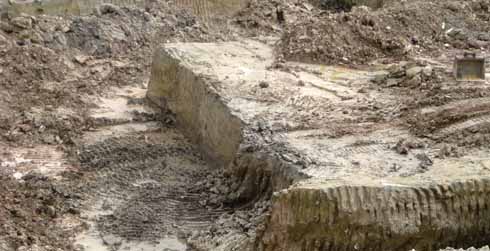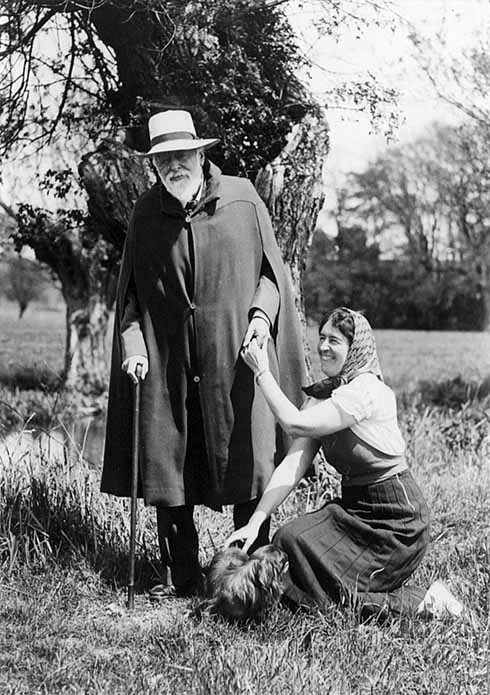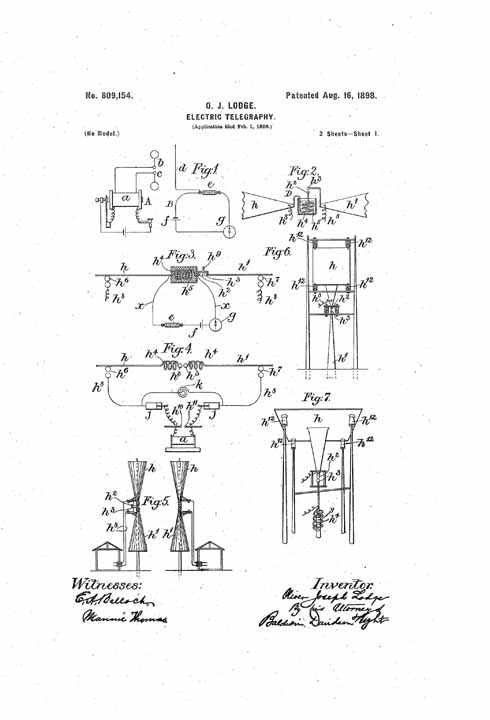Fate of clay
John Rowley looks at the life of Purbeck ball clay agent, Oliver Lodge, and how the money from selling Purbeck clay led to the development of wireless telegraphy, the spark plug and electrostatic dust removal
Published in February ’12
The Isle of Purbeck and the motor industry may seem like an unlikely combination, but they are inextricably linked thanks to a Purbeck clay company, a railway clerk bent on self-improvement and his scientist son.
The first actor in this piece was a London entrepreneur, Benjamin Fayle, who came to Purbeck to exploit its clay resources. It was he who first brought the railway – or rather the plateway, where the flanges, which keep the train from derailing, are on the track not on the wheels – to Dorset in 1806. In the eleven years after he bought his quarry in 1795, thanks in part to the improved transportation of clay and thanks to an increase in demand, there had been a corresponding increase in production by half, from 14,500 tons to 22,000 tons.

Benjamin Fayle’s plateway in Norden, heading towards Middlebere. A year after the line opened, Fayle informed Josiah Wedgwood of a fall in the price of clay. This was thanks to the opening of the line, which significantly reduced the number of men needed to move the clay.
In the late 1850s, twenty years after Benjamin’s death, B Fayle & Co was run by four partners: Charlotte Fayle, who had taken over the running of the firm from her father Benjamin, her brother–in-law, Benjamin Guy Babington, his son (Charlotte’s nephew, Stephen Piele Babington) and her brother, Rev. Richard Fayle, who was a sleeping partner as he was busy with his parish in Torquay.
The company had advertised in Staffordshire for an agent to sell Fayle’s Purbeck blue clay, now known as ball clay, to the Staffordshire potteries. The potteries represented a huge market for Purbeck’s clay producers, and B Fayle & Co did not wish to miss out.
A cashier in his early 30s, then working for the North Staffordshire Railway, was looking to better himself and saw this agency as an opportunity not to be missed. His name was Oliver Lodge and he applied for the Fayle agency and was asked to meet the partners in London.
To impress them he had borrowed a carriage and a pair of horses from his brother; he also asked his many friends to write enthusiastic letters about him, some of which he half-dictated. Charlotte was said to be difficult as a partner, but Oliver Lodge obviously impressed her, for he secured the agency.
Lodge did well, and a coach house was built and a horse and phaeton secured for driving around the potteries to obtain the orders for B Fayle and Co’s Purbeck blue clay. Mr Babington used to arrive periodically and drive round with Lodge and visit potteries with him. They would return to the Lodges’ house where Grace Lodge (Oliver’s wife) would lay on a feast. Mr Babington was known for his love of walnuts and wine; his rich fruity voice was ascribed to his eating of nuts.

Lodge Hall: home of Oliver Lodge senior (and later Sir Stanley Matthews) and birthplace of Oliver Lodge junior (later Sir Oliver)
B Fayle & Co’s clay was shipped from Purbeck via Poole by the shipping agent (George Penny) to Runcorn on the Mersey, for transmission by canal to the Potteries. Sometimes a bad seam of clay would be struck, and when potteries felt anxious about the quality, this would be reported to Oliver Lodge, whereupon he would make inspection visits to Purbeck to resolve the quality problems being experienced by the potteries.
It became apparent to Oliver that potteries required a whole variety of minerals for the manufacturing process so, in addition to Purbeck clay, he added the agency of Walker, Parker & Co for white lead used as a glaze, agencies for china clay and cobalt and began to import a crystal substance called ‘tincal’ – a substitute for the expensive borax used in the glaze – from the Himalayas. The business now owned a good many horses and carriages. Oliver Lodge now travelled around the Potteries in a brougham instead of an open vehicle and decided to call his firm ‘Oliver Lodge & Son’ in the hope that his son – also called Oliver – would take over the running of the firm later.
It was, though, his brothers Alfred and Frank who became involved in the running of the firm. Alfred eventually stood down and let his younger brother Frank take over the whole business and put it on a proper basis, with paid clerks. After this, Oliver Lodge senior gave up his house (which was much later bought by Sir Stanley Matthews), lived in hotels and died suddenly, in 1884, the year after the death of Charlotte Fayle; she had been the last Fayle to be involved in the clay business although the company lived on for many years thereafter.
Oliver junior had, in line with his father’s wishes, helped with the family business from the age of fourteen (when he left school), until he reached the age of 22. His aunt, Anne, who had been a Woman of the Bedchamber to Queen Adelaide, was a woman of great natural ability and considerable education.
At the death of Queen Adelaide, Anne was left a sum of money which, wisely invested, gave her independent means. She thought that selling clay was not good enough for her nephew and set about facilitating the changing of his situation. She arranged for him to attend a series of scientific lectures on heat, which were given by Professor Tyndall of the Royal Institution; it was Oliver’s first introduction to physics.
He spent the winter with his aunt and attended many other lectures on subjects such as geology, history and religion. At the end of the winter he went back to travelling selling Purbeck ball clay although, having heard of classes in chemistry at the Wedgwood Institute, he attended these and, bitten by the science bug, then enrolled on a course of a range of scientific studies. He sat examinations in eight subjects obtaining a first in all eight.
The pattern was set: winters with his aunt in London, the rest of the year working for his father while attending lectures. Eventually he decided on his destiny, read for a Bachelor of Science in 1875 and became a Doctor of Science in 1877. For a while he taught ladies at Bedford College until he was appointed professor of physics and mathematics at University College, Liverpool in 1881. In 1900 Lodge moved from Liverpool to the Midlands and became the first principal of the new Birmingham University, remaining there until his retirement in 1919.
Oliver was interested in electricity, electromagnetism, light, radio waves, x-rays and so on. Lodge also studied electromagnetic radiation and, in 1887, he discovered that travelling waves and standing waves were produced along conducting wires as a result of oscillations involving the discharge of a Leyden jar. These waves were measurable and followed precisely the theory of electromagnetism established by James Clerk Maxwell. German physicist Heinrich Hertz had generated similar invisible radiation and Oliver invented an improved device for detecting these ‘Hertzian’ waves, called a coherer, which contained metal particles that stuck together in the presence of these waves.
He concentrated on studying long wavelengths, making him the leader in early radio communication. In 1894, a year before Marconi, he transmitted radio signals to demonstrate their potential for communication; he used radio waves to carry Morse code signals fifty-five metres and would eventually become a major contributor to the early development of wireless telegraphy. Oliver was knighted by King Edward VII in 1902 and died in 1940. Four of Sir Oliver Lodge’s six sons went on to run two firms based on his inventions; Brodie and Alec created Lodge Plugs Ltd to manufacture spark plugs and Lionel and Noel created the Lodge Fume Deposit Ltd using an electrostatic dust removal system.
According to the Purbeck Mineral and Mining Museum, in 2002, Purbeck ball clay was an essential ingredient in half of the sanitaryware made worldwide and, although impossible to verify, is claimed to have been used in the production of a third of all the fine china ever made. More than this, though, were it not for the wealth created by selling Purbeck clay to the potteries by Sir Oliver Lodge’s father, and his aunt’s love of learning, the worlds of radio, motoring and the control of man-made industrial pollution and the atmosphere would be markedly different.





